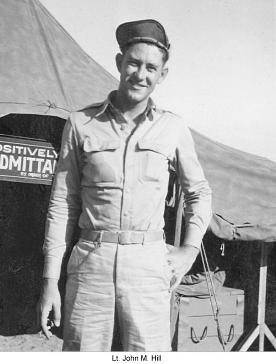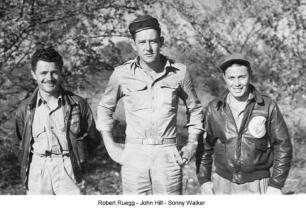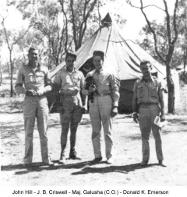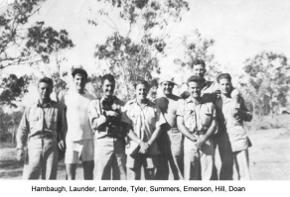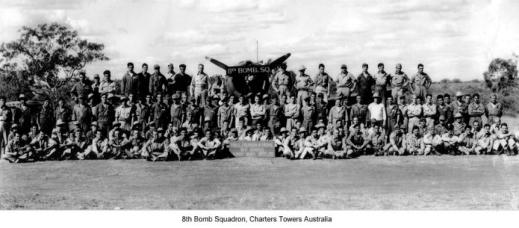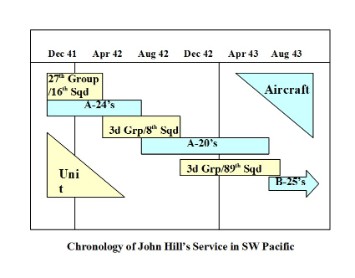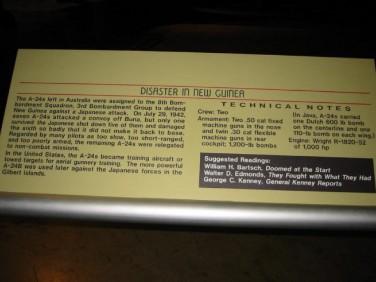CHRONOLOGY OF SOUTHWEST PACIFIC WW II SERVICE OF JOHN M. HILL
The following is a summary of John’s service, primarily taken from correspondence to and from the States during WW II (with some notes from other sources), saved by his wife Virginia and mother Gladys.
31 Oct 1941 – After completing his pilot training, Lt. Hill is awarded his wings at Stockton Airfield, California. His correspondence with a certain Miss Virginia Hohlaus does not seem to be moving in the right direction (evident from his letters) and he volunteers for Pacific duty. His unit is the 27th Bombardment Group, 16th Bombardment Squadron.
Early Nov 41 – Although he has gotten some last minute favorable responses from Miss Hohlaus, Lt. Hill sails from the U.S. aboard the W. A. Holbrook Army transport, bound for Hawaii. The ultimate destination for his Group is Manila, Philippine Islands (PI). (Note: The Japanese have been acting belligerent and the Philippines are considered a likely spot for them to initiate an attack).
1 Dec 41 – After spending a week in Honolulu, Hill departs Hawaii. The initial cadre of the 27th Bomb Group left the U.S. about 3 weeks ahead of Hill and is already in PI, minus their planes. The initial A-24 dive bombers for the 27th are aboard Hill’s convoy. [Note: Appendix B gives a summary of the A-24]
7 Dec 41 – The Japanese attack Pearl Harbor, Hawaii. Having received word of the attack, the crew of Hill’s ship paints over the American flags and other markings on the ship. The ship is diverted and steams toward Australia instead of PI (see previous discussion).
18 Dec 41 (another reference says 22 Dec) – Hill arrives in Brisbane, Australia. His unit awaits further orders. The 27th now enters a tragic phase. The men in PI are stranded with no instructions and no airplanes. Despite their pleas, none of the aircraft with Hill’s unit in Australia are sent to them. As it turns out, the A-24’s had arrived missing gun mounts and other vital equipment. Some of the men of the 27th at PI are sent to Australia (and return for some limited bombing missions in early April), but the rest remain and are ultimately involved in the defense of the Islands. As the Japanese sweep South, the men are issued rifles and fight courageously as foot soldiers. With the fall of PI in April, 1942, the remaining men of the 27th become part of the infamous Bataan death march. It is left up to Hill and the others to carry on for the 27th.
25 Feb 42 – The 3d Bombardment Group (The “Grim Reapers”) arrives at Brisbane, Australia. They are stationed at the Ascot racetrack. They begin training along with the members of the 27th in the A-24.
6 Mar 42 – The 3d and 27th move to Charters Towers, Australia to train. (See pictures in Appendix G). They are training for dive bomb interdiction missions, to be supported by the P-39 and P-40 escorts from the 75th and 76th Squadrons of the Royal Australian Air Force (RAAF). The Japanese by now have become firmly entrenched in New Guinea, New Britain and Papua except for the southwest corner (see New Guinea map). Australia is threatened.
31 Mar 42 – Hill is part of the initial group of 13 airplanes, led by Captain Floyd Rogers, that fly from Charters Towers to Port Moresby, New Guinea in preparation for combat. They set up shop at the Koki Mission. Between Port Moresby and the Japanese is the Owen Stanley mountain range, penetrated by only a few roads such as the Kokoda trail. The Japanese possess air superiority.
1 Apr 42 – Hill and six other A-24’s fly the first U.S. combat mission in the SW Pacific theater. The target is the Japanese airfield at Lae. The target is weathered out so the planes hit Salamaua instead. Little damage is caused, but the Americans now have their feet wet.
2 Apr 42 – The remnants of the 27th Bomb Group are officially transferred to the 3d Bomb Group, 8th Bomb Squadron, flying A-24’s. The initial B-25’s “acquired” from the Dutch are distributed to the 13th and 90th Bomb Squadrons. The 3d continues to fly interdiction missions against airfields and shipping and close air support for the Australian ground forces.
11 Apr 42 – A mission to Lae.
4-10 May 42 – The famous battle of the Coral Sea takes place in which a
Japanese task force is severely hammered by American aircraft. It is
believed that Hill was on patrol during this period but his A-24 did not
have sufficient range to join in the combat.
10 Jun 42 – 3d HQ
moves back to Charters Towers although missions continue in New Guinea.
Many interdiction missions are flown along the Buna Trail. The 3d is
experiencing some losses and the number of combat-ready A-24’s is
dwindling.
22 Jul 42 – The 3d returns to Port Moresby and the number of missions are stepped up.
29
Jul 42 – The “Ralph Sam” mission reported in the papers occurs. [Note:
Appendix C contains additional information about this mission, including
an interview with then Major Hill in 1945. Additional details about his
service are included.] Major Rogers leads a flight of 7 A-24’s
(including Hill) to attack a Japanese convoy of eight ships North of
Buna. The P-39 escort turns back but Major Rogers decides to lead the
flight in anyway. They are jumped by a group of Zeros and Major Rogers
is shot down almost immediately. Of the seven aircraft, three go down
and two ditch (their crews are later captured). Only Lt Wilkins makes it
directly back to Port Moresby (and some histories claim he was the only
survivor). Lt Hill is pursued by a Zero who shoots up the A-24 badly.
Hill’s gunner, Ralph Sam (an American Indian), has his right hand and
leg shot up but continues to fire his machine gun (and his .45 pistol
when he runs out of ammunition) with his left hand. Hill has to put down
at Milne Bay. Sam was flown to Australia but he couldn’t be saved. Hill
flew his patched up plane back to Port Moresby. This mission had a
shock effect on the unit. Shortly thereafter, the A-24’s were declared
unfit for combat. A-20’s and B-25’s began arriving as replacements.
[Note: A year after this mission, the other survivor, now Major Wilkins,
earned the Congressional Medal of Honor posthumously for a mission he
led against a Japanese convoy].
Aug 42 – Hill returns to Charters
Towers and begins training in the A-20’s. [Note: a summary of the A-20
aircraft is given in Appendix D.]
22 Aug 42 – Hill is given two weeks rest and recuperation in Australia.
2 Sep 42 – The remnants of the 8th Bob Squadron (3d Bomb Group) are now assigned to the 89th Squadron at Port Moresby.
6
Sep 42 – Hill comes off R&R and begins flying missions with 89th
airplanes on a rotation basis. The Allied efforts are beginning to take
effect – they are controlling the skies and the missions are becoming
more routine.
25 Dec 42 – Hill writes to say he thinks he will be
home in six months. He has been in the theater for a year. McGilivray
and Aufderhide are the only other original squadron members left.
3
Mar 43 – Battle of the Bismarck Sea. A Japanese relief convoy from
Rabaul to Lae is intercepted. Most of the convoy is sunk. It can’t be
confirmed if Hill participated.
Mar 43 – Hill makes Captain.
Apr
43 – Hill is part of the first group to fly over Owen Stanley range and
set up operations North of these mountains in New Guinea.
17 May 43 – Hill continues to fly missions – he is believed to have accumulated over 60 missions by this time.
20 May 43 – B-25’s are assigned to the 89th Squadron. This will become one of the workhorses for the Americans in the theater.
24 May 43 – The first missions by the 89th Squadron with the B-25’s are flown.
June 43 – Hill returns to the U.S. He is assigned to train other pilots.
29 July 1942 Mission
INTERVIEW WITH MAJOR JOHN HILL, AT MITCHELL FIELD, MAY 1, 1946
- - - - - - - - -
(Hill was not in the Philippines with the 27th but came out to Australia with MacGillivray (Interview #E27). They sailed from Hawaii on December 1, and were a week out when news of the war overtook them and they were diverted to Australia with the 27th Bombardment Group’s planes.)
Last Raid of the A-24’s
On or about July 27th (actually July 29,
see Walker – MacGillivray #E27) there were eight A-24’s back at Port
Moresby. These planes had been sent down as unfit for combat, as they
were considered too slow and too vulnerable. But with the Japs beginning
to move along the north coast of New Guinea, the planes were recalled,
and Hill’s outfit, which had been training in A-20’s, took them back to
Moresby.
The formations were led by Major Floyd “Buck” Rogers, and the three elements were lined up like this:
Major Rogers - 2dLt John Hill - 2dLt Raymond Wilkins
Captain Virgil Schwab - Lt. Dean - 2d Lt. Parker
Captain ______ 2nd Lt. Cassels - 2d Lt. MacGillivray
On this mission, MacGillivray had some sort of engine trouble and had to turn back.
They
were due to hit a convoy supposedly 50 miles up the coast from Buna.
They did not know what the convoy consisted of – intelligence didn’t go
that far. They took off with some P-39’s that were to furnish their
protection. There were two flights of ten each, of these P-39’s – one
for immediate cover, the other for high cover. But the A-24’s lost the
fighters sometime after they had got near Buna. It was also then that
Cassel’s bomb fell off. They were carrying 4 – 500 lb bombs. They tried
to get Cassel’s attention and explain to him what had happened but they
could not make him understand. They dared not break their radio silence,
so he went on in like an old maid.
It was fine weather for the
attack. There was a light overcast at around 7 or 8000 feet that they
could see through, and they were in close when they spotted the convoy.
It consisted of three transports lying astern of each other, with a
destroyer on each side of it – two miles apart from each other.
Before
they got to the convoy, the planes went into echelon to the right and
Buck Rogers took the first transport and peeled off through the overcast
at it. Hill took the second transport after Rogers had peeled off; and
after that he does not know how the planes went down. He saw Buck’s bomb
hit the sea about 50 yards to the right of his target; Hill himself did
a little better but also missed, and he pulled out of his dive to
strafe the ship. The plans were that they would pull out in a 180 degree
heading and form up on their lead ships, and Hill did that. But when he
came out of the dive he saw Rogers off on his right and about tow or
three miles away. Rogers was in a sharp turn to the left and only a few
feet above the water, and there were two Zeros on his tail. Before Hill
could get up close, Rogers crashed and burnt in the sea.
So Hill
pulled up to try to reach the clouds hoping to get there before the
Zeros after Rogers could spot him. But he had made only about 2000 feet
when one of them came after him. When the Zero got up close, Hill dived
again as he would have been a sitting duck in the air. That Jap chased
Hill for nearly forty miles. Hill dived every which way. Most of the
time he was skating. The Jap got in about two good bursts on Hill; and
Hill thinks that it was on the second burst that the Jap got his gunner.
He doesn’t know. He never has a chance then to look around. He was just
flying.
While Hill was climbing out of his original dive on the
transports, he had seen Lt. Wilkins go on down under him. Wilkins was
now ahead, and Hill never could catch up with him. Now he looked back
and saw the Zero, which had been chasing him, turn over on its back and
start shooting at him that way. Just what the Jap pilot thought he was
doing is something Hill had never figured out. Maybe he was just feeling
frustrated, or else gay – you can’t tell about a Jap. He hadn’t done
much damage except on those two bursts – the second of which sprayed the
whole plane.
The Jap left Hill when Hill hit the coast. Hill
flew in low over the trees. He could see Wilkins now five or six miles
inland and climbing and the Jap went off to the right after Wilkins. He
gave Wilkins a burst in the belly, coming up at him from under. But
Wilkins’ gunner felt pretty sure he had got some hits in on the Jap, for
he turned back home and they didn’t see him any more.
The gunner
in Hill’s plane was an Indian named Ralph Sam. He had been hit in the
right hand by a 30 cal shell which nearly took the hand off. Another hit
him in the right thigh and broke his leg. He couldn’t handle his guns
anymore, so he got out his .45 and started shooting that left-handed at
the Jap.
When the Jap left them, Hill saw that Sam was badly hurt
and as they had gone far south in this running fight, he decided to
land at Milne Bay and get him into the hospital as it was so much
nearer. They got Sam to the hospital all right and Hill came back to the
ship to see what could be done about it. The rudder and elevator
surfaces were all shot to hell and there wasn’t any real repair setup
there at Milne Bay. But the Australian mechanics found some flowered
gingham and they doped it up and stuck it on which made the ship look
like something. Then Hill went back to see Sam whom he found cheerful
and they talked a while. They thought Sam would be all right. He was
taken off to Australia in a flying boat, but he died there three or four
or five days later of gangrene.
Next morning Hill flew back to
Moresby in his patched plane and got a real job done on it there so he
could fly back to Australia with MacGillibray’s plane and Wilkins’.
MacGillivray was the only one left fit to fly over the mountains. The
A-24’s never came back to New Guinea. They went back into the A-20’s
after that; but Hill was sent to a rest camp for a while and missed the
Kokoda business. He (Wilkins?) had got engaged to an Australian girl. He
was finally shot down over Rabaul.
Hill was in the first flight
to go up to New Guinea. Robert Ruegg led the flight up as Rogers was
sick with Dengue fever. Ruegg was second in command of the squadron.
They went up the 31st of March 1942. They pulled their first mission on
the 1st of April and this mission was the cause of Hill’s getting the
worst tongue-checkering he ever got. They were supposed to hit Lae, with
Salamau for a secondary target. Wilkins and Hill both had trouble, the
first with his engine and Hill because he could not get one wheel up, so
they lagged until the other ships were out of sight. But they kept on
going. There was a huge thunderstorm over Lae so they went in on Salamau
which probably saved their livers, for they would have been sitting
ducks over Lae. They lost each other and flew back alone. And when they
got back the Australian Squadron leader of the 75th Squadron (P-40’s)
came over and bawled the hell out of Hill for not knowing enough not to
go in on a target if his plane wasn’t in good shape. He said planes were
too scarce to be thrown away.
Johnny Jackson was in command of
the 75th Squadron and Peter Turnbull commanded the 76th (also
Australian) at Milne Bay. When the A-24’s got to 3-mile field there were
seven, eight or ten P-40’s at Moresby. They went up after anything the
Japs sent over and finally by the law of averages they got whittled
down. But they had some great fliers, a few who had been aces over in
Africa. These planes were the only sole air defense in New Guinea in
those days. The Japs used to send over twice a day. First the Zeros
would come strafing about 9 AM, and when they had finished going over
the fields they would head out above the Bay and dog-fight with
themselves ‘till it was time to go home. Then between 10 and 12 the
bombers would come over, bringing their own Zeros with them, of course.
The
A-24’s were pretty vulnerable. They lost a good many boys over Lae when
they were working there with no fighter cover. That was why they
finally had been sent out to Australia, as they had thought for good.
But when the Japs got down opposite Buna they were within reach of the
P-39’s so it was thought that with fighter cover the A-24’s could get
away with it. The trouble was that the P-39’s lost them, and they had to
go in as usual alone. All the boys who were downed over Lae failed to
turn up. But some of the B-25 people got out. There was Pete Bender
whose plane exploded and threw him out. He never remembered opening his
chute but came to in the air. Col. Shearer (sp?) got shot down over Lae
and he got out and so did George Farr.
The greatest day he
remembers was the one they saw the P-39’s coming in to Moresby. There
were about 50 of them in two flights of 25 each and Buzz Wagner was
leading them. As Hill remembers they came in about noon and went out on a
mission in the afternoon (see interview with Walker and MacGillivray,
#E27, which says they went out the next morning, having arrived before
dusk.) Wagner got three planes on this mission. He was a colorful
looking fellow with his Hemmingway mustache (which he had ‘till he grew
his beard.) Wagner could do a slow roll with a 40 on a P-39. Hill has
seen him do it in a practice dog fight over Amberley Field.
Hill
says none of their own people stood out in those early days. There is
less chance of developing an outstanding flier in a bomber group because
there is an entirely different kind of battle to fight. And at that
time they were mostly green and still learning. But today, D. P. Hall
could be classed with Wagner in his own way. He led most of the
successful missions the group went on and as he got more planes to work
with he did terrible execution on the Japs. But these later days of
richness came after Hill returned to the States.
Pappy Gunn was
with them from the early spring of the year; Hill does not remember just
when he did join the group. But Gunn was the craziest flier he ever
saw.
Ruegg bought an Irish terrier pup in Australia, a very well
pedigreed dog, named Colonel James Patrick. They had his papers for his
commission all made out and properly signed and he also had a silver
star. He flew up whenever they went to Port Moresby on a mission, and
generally in Hill’s plane. Col. Patrick always crawled back as far into
the tail as he could get, though. He hated flying because it bothered
his ears and he would spend a large part of the flight complaining about
it, and growling and sticking his paw in his ear.
Whether it was the
vibration or the pressure or both, Hill did not know. But he liked it so
at Port Moresby he was willing to go. He thrived on the jungle and he
had a continual war with the Kangaroo rats and would chase them
continually. He found one in a foxhole once and dove in there and killed
him. Other times he would like to go off swimming. When Ruegg left, he
made over Col. Patrick to Hill and Wilkins and then Col. Patrick stayed
with the squadron and moved over the Owen Stanleys when they shifted
their base to Dobodura; and he has stuck with the Squadron ever since.
They say he has got himself a fine family during all this island hopping
and is now established in the Philippines. Hill hasn’t heard whether
the Colonel plans to be in on the taking of Tokyo.
At Port
Moresby they were quartered in Koki Mission which wasn’t a bad place at
all. There were two large rooms downstairs; one for the enlisted men’s
mess and one for the officers’. Upstairs there was a large room they
used as a sort of lounge where they had a radio phonograph and off the
other room upstairs was a large porch closed in with lattice which they
used to sleep on. The only thing that got the best of them was the
Australian rations. Mutton and carrots – to this day Hill can’t face
carrots and is glad he doesn’t have to face mutton.
The Japs
could have had New Guinea for the asking practically, if they had played
their cards right. The boys were all set and had their plans made to
take to the hills.
They went out on patrol during the Coral Sea business but the fleet never got in range of the A-24’s.
Right
after the final A-24 mission they went into A-20’s as stated and they
used to do a lot of work with them. They were great planes for the job,
and you learned to fly through the top leaves with them. With the A-24’s
they would take off and climb high enough to get over the mountains and
then go in about 8000 or 9000 onto the target. But the idea with the
A-20’s was to keep low and they’d follow down the creases of the jungle.
There wasn’t any particular roughness to encounter with this flying in
the passes – the planes went so fast it would take a hell of a draft to
make one feel it. But they did some flying that was pretty close.
There
was one place on the way from Salamau to Wau that the Japs had a small
advance base on and the Australian troops could not move them off it. It
was on a small hill in a deep circular valley and the A-20’s used to go
in on that and scream down into the valley and come bursting out again,
with just an interval in which they could fire and drop bombs at the
bottom of the dive. It was quite a thing to watch the plane ahead of you
go down and pull up out of the hole.
[Note: John Hill rose to the rank of Colonel in the Air Force and died
in an automobile accident on December 6, 1964, while still on active
duty. In addition to his service in WW II, he also served in the Korean
War and had overseas duty in Japan, Turkey and Thailand. His decorations
were the Silver Star, Purple Heart, Distinguished Unit Citation,
American Defense Service Medal, American Campaign Medal, Asiatic Pacific
Campaign Medal, World War II Victory Medal, China Service Medal,
National Defense Service Medal, Korean Service Medal, Armed Forces
Expeditionary Service Medal, Air Force Longevity Service Award and the
United Nations Service Medal.]
